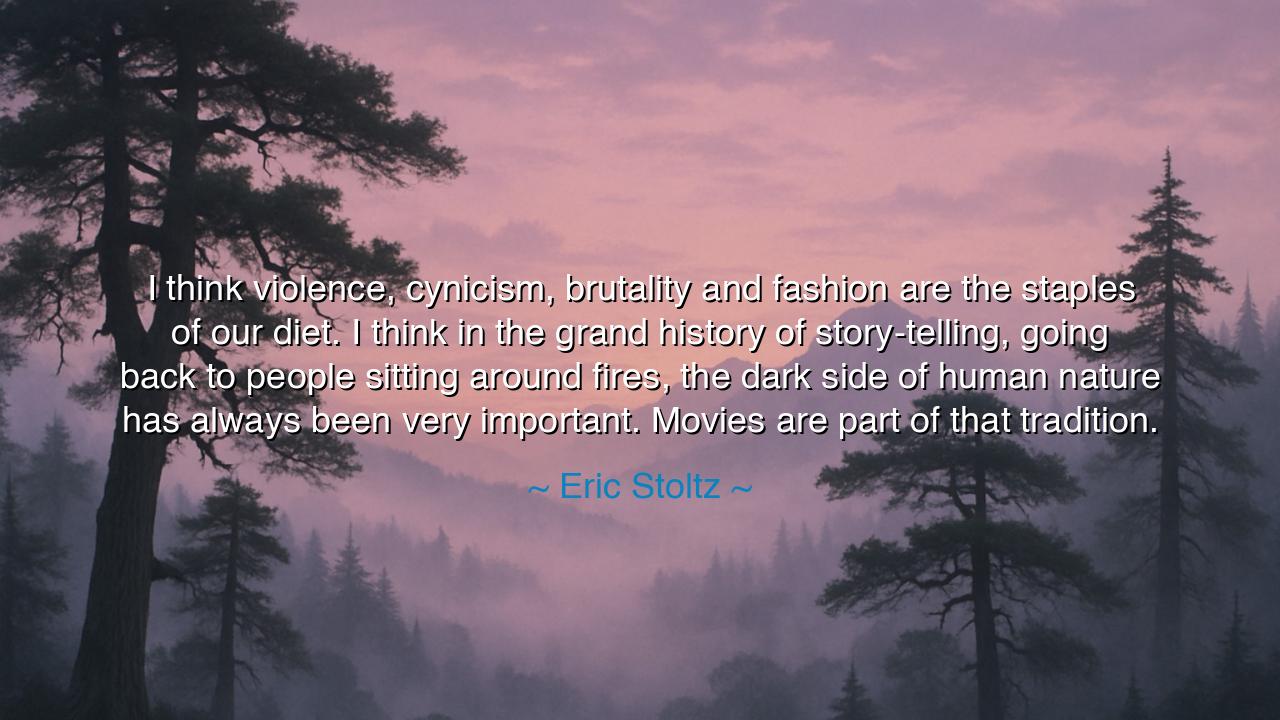
I think violence, cynicism, brutality and fashion are the staples
I think violence, cynicism, brutality and fashion are the staples of our diet. I think in the grand history of story-telling, going back to people sitting around fires, the dark side of human nature has always been very important. Movies are part of that tradition.






When Eric Stoltz declared, “I think violence, cynicism, brutality and fashion are the staples of our diet. I think in the grand history of storytelling, going back to people sitting around fires, the dark side of human nature has always been very important. Movies are part of that tradition,” he spoke not as a cynic, but as a philosopher of art—one who understood that the mirror of storytelling must reflect light and shadow alike. His words reveal a truth as old as civilization itself: that humanity’s hunger is not only for comfort and beauty, but also for understanding the depths of its own darkness. He reminds us that the stories we tell, from the fires of prehistory to the glowing screens of modernity, are rituals of reckoning with who we are and what we fear.
In speaking of violence, cynicism, brutality, and fashion as “the staples of our diet,” Stoltz draws a startling metaphor. Just as the body feeds on bread and water, so too does the spirit feed on the spectacle of conflict, struggle, and desire. This is not a condemnation of humanity, but an acknowledgment of its complexity. The ancients knew this well. The tragedies of Sophocles and Euripides, soaked in blood and betrayal, were not written to glorify suffering, but to reveal the sacred pattern within it—to show that from the darkness of human error comes the light of understanding. In the same way, modern films, no matter how cynical or violent, continue this ancient function: to hold a mirror before the soul and ask, “Do you recognize yourself in this?”
When he speaks of the “grand history of storytelling,” Stoltz invokes a lineage that stretches back to the dawn of firelight—to the time when humanity first gathered in circles to ward off the night with tales of gods, monsters, and men. Those fireside stories were not trivial entertainment; they were acts of survival, teaching courage through fear, wisdom through sorrow. To tell a story of violence was not to indulge in it, but to contain it—to give chaos a name and shape, so that it might not devour the mind. The ancients called this catharsis: the purging of the spirit through the confrontation of its own darkness. Every storyteller since has been a keeper of that flame.
Consider the tale of Oedipus, who blinded himself after discovering his own crimes. The Greeks did not tell this story because they loved horror, but because they believed that only by facing horror could one awaken to truth. In the same way, the modern world’s fascination with film—its endless appetite for stories of war, betrayal, and corruption—serves the same ancient purpose. Through the screen, we rehearse the same moral dramas that were once spoken in caves and courts: What is evil? What is justice? What is the cost of power and pride? These questions, ancient and unending, form the staples of our emotional diet.
And what of fashion, which Stoltz lists alongside brutality and cynicism? It may seem an odd companion, yet it reveals the same truth: that humans adorn themselves even as they destroy, that vanity and violence spring from the same desire—to assert meaning in a fleeting world. The ancient warriors painted their faces before battle, just as the modern individual dresses for survival in the social arena. Fashion, like storytelling, is a performance of identity; and identity, fragile and restless, is always born from tension between what we are and what we wish to become.
Stoltz’s insight also carries a warning. To feed too deeply on darkness without reflection is to grow sick on it. The ancients feared this, too. The philosopher Plato cautioned that those who look too long into the abyss of imitation—the actors, the poets, the dreamers—risk losing their grasp on truth itself. Yet he could not silence the poets, for their art was necessary. So too today, we must balance the consuming fascination with violence and cynicism by remembering the reason we tell such stories: not to glorify the fall, but to understand it. The storyteller’s duty is not to soothe, but to awaken.
Thus, the lesson of Stoltz’s words is not despair, but awareness. He reminds us that stories of darkness endure because they speak to what is eternal in us—the struggle between creation and destruction, compassion and cruelty. To reject such stories is to deny a part of our nature; but to embrace them without wisdom is to let that nature consume us. The task, then, is to watch, listen, and discern—to consume these tales not as passive spectators, but as seekers of truth.
So, let us remember: the fire that once lit the faces of our ancestors still burns today—in the flicker of a theater screen, in the glow of a storyteller’s words. It feeds us, challenges us, and reminds us of our shared humanity. As Eric Stoltz understood, the dark side of human nature is not our shame—it is our teacher. To confront it through story is to keep the ancient fire alive, and to ensure that, even in the shadows, the light of understanding never dies.






AAdministratorAdministrator
Welcome, honored guests. Please leave a comment, we will respond soon